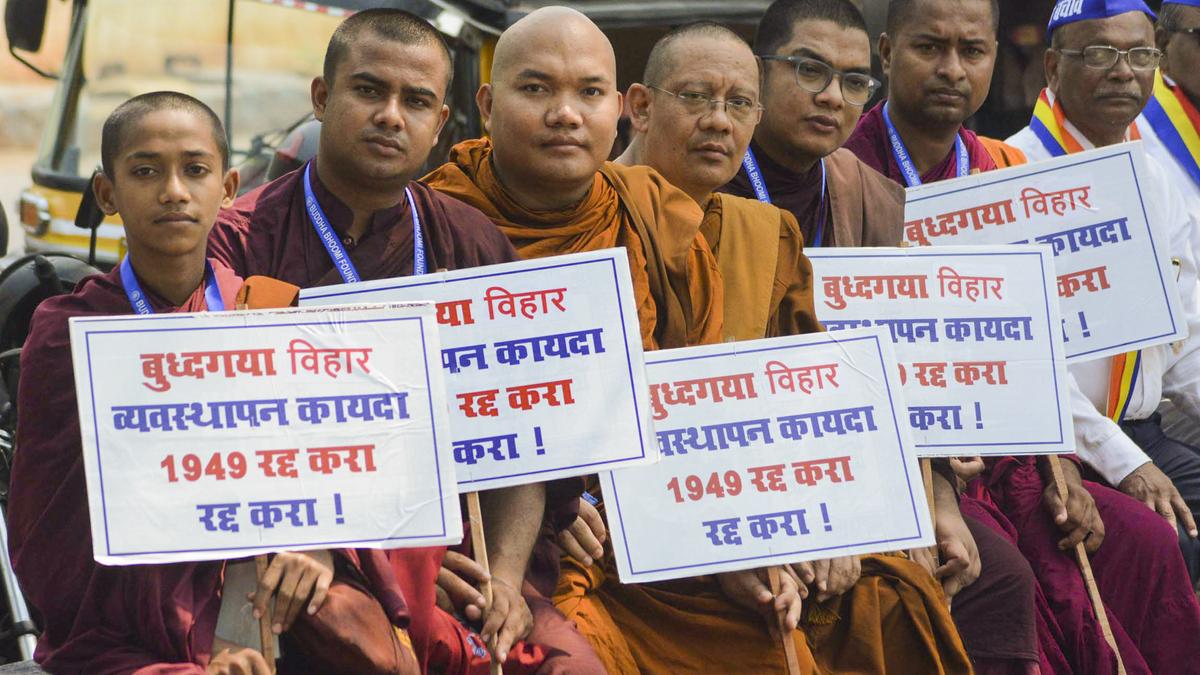Buddhist monks hold placards during a protest, demanding the repeal of the Bodh Gaya Temple Management Act, 1949, in Thane, Maharashtra on March 25
| Photo Credit: PTI
The story so far: Beginning February, nearly 100 Buddhist monks under the All India Buddhist Forum (AIBF) have been protesting, first at the Bodh Gaya’s Mahabodhi Temple or Mahavihara, and later a little down the road, demanding a repeal of the Bodh Gaya Temple Act (BTA), 1949. The AIBF has support from prominent Buddhist bodies, and has submitted a memorandum to the Bihar government. The Bodh Gaya is one of the four sacred sites of Buddhism; the other three being Buddha’s birthplace Lumbini, Sarnath where he gave his first sermon and Kusinagar where he attained parinirvana.
Have there been protests before?
In November 2023, Buddhist monks held a rally in Gaya and submitted a memorandum to the Central and State governments. As it failed to have the desired effect, the monks scaled up the protest and held a rally in Patna last year to press for repealing the Act. Back in 2012, monks had filed a writ petition before the Supreme Court to repeal the Act. The petition is yet to be heard.
What is the Act?
The BTA established an eight-member management committee having equal number of Buddhists and Hindus. The Act made the local district magistrate an ex-officio chairperson of the committee. As the district magistrate hailed from the majority community, it translated to a Hindu majority on the committee, something which was resented by Buddhist bodies. Ever since then, various Buddhist bodies have been raising their voice intermittently for gaining autonomy over the Bodh Gaya temple, which they call the Bodh Gaya Mahavihara.
What do the annals say?
Noted poet Edwin Arnold in his well-known poem, ‘The Light of Asia’ talks about Gautam Siddharth’s enlightenment under the Bodhi tree. Bodh Gaya was then described as the Mecca of Buddhism, and in many ways popularised Buddhism in the West. However, Bodh Gaya’s claim to fame goes much further back in time. In the third century, Mauryan Emperor Ashoka worshipped the Bodhi tree and built the temple there. From the time of Ashoka to the Palas, the Bodhi temple continued to be a Buddhist place of worship and a site of pilgrimage. Chinese traveller Hiuen Tsang visited it in 629 AD during the reign of Harshavardhana. Incidentally, Hiuen Tsang called it a Buddhist site, and is said to have found only Buddhist relics here save for a statue of Avaloktishvara.
Things changed with the invasion of Bakhtiyar Khilji in the 13th century. The invasion ended the Pala rule, and thus began the decline of Buddhism. During Akbar’s reign, in 1590, a Hindu monk established the Bodh Gaya mutt. With this the temple lapsed into the hands of the Hindu community. Following Independence, the Bihar Assembly passed the BTA in 1949 and control of the temple was transferred from the Hindu head to the new management committee.
How has the government intervened?
The BTA was passed by the Bihar government to resolve a festering dispute between the Buddhist and Hindu heads of the Mahabodhi temple for control over the same. The Buddhist side was unhappy at the stipulation that the district magistrate, who was the ex-officio chairman, could only assume leadership if he was from the Hindu community. It changed in 2013 after the State government amended the rule and inserted a provision for the ex-officio chairman to be of any faith.
In the early 1990s, then Chief Minister of Bihar Lalu Prasad Yadav, drafted the Bodh Gaya Mahvihara Bill to replace the BTA. It was supposed to hand over the management of the temple to the Buddhist community. The Bill prohibited idol immersions near the temple and Hindu marriages inside the temple. However, the Bill went into cold storage.
Published – March 31, 2025 08:30 am IST
